Performance Analysis of a 10 MW Ocean Thermal Energy Conversion Plant Using Rankine Cycle in Malaysia
Abstract
1. Introduction
2. Analysis Method
2.1. OTEC Potential and Profile of Temperature
2.2. Rankine Cycle
2.3. Objective Function
2.3.1. Net Power
2.3.2. Heat Transfer Area
- (a)
- Boiling Heat Transfer Coefficient
- (b)
- Condensation Heat Transfer Coefficient
- (c)
- Heat Transfer Coefficient of the Seawater side (Evaporator and Condenser)
2.4. Objective Function and Its Variables
Condition and Calculation Method
3. Results and Discussion
3.1. Minimum Objective Function
3.2. Pumping Power and Net Power
3.3. Warm and Cold Seawater Flow Rate
3.4. Heat Transfer Area
4. Feasible OTEC Plant Specification
5. Conclusions
- The value of the minimum objective function is decreased when the inlet temperature difference (TWSWI − TCSWI) is increased as can be seen in the Figure 5 (comparison between Equations (38) and (39)). Pertaining to this value, the minimum objective function versus the inlet temperature difference was derived and shown in Equation (38). Comparing 10 MW and 100 MW, the objective function of 10 MW is larger, resulting in a higher CAPEX.
- The value of the warm seawater pumping power and cold seawater pumping power is decreased when the inlet temperature difference (TWSWI − TCSWI) is increased.
- Even if the inlet temperature difference is increased, the working fluid pumping power is constant. The working fluid pumping power is as small as 200 kW.
- Because the pumping power of the warm seawater and cold seawater decreases when the inlet temperature difference (TWSWI − TCSWI) is increased, the value of the net power is increased when the inlet temperature difference (TWSWI − TCSWI) is increased.
- The warm and cold sea water flow rate decreases as the inlet temperature difference increases.
- The value of the total heat transfer area, the heat transfer area of the evaporator, and the heat transfer area of the condenser decreased when the inlet temperature difference (TWSWI − TCSWI) is increased.
Author Contributions
Funding
Institutional Review Board Statement
Informed Consent Statement
Data Availability Statement
Acknowledgments
Conflicts of Interest
Nomenclature
| A | heat transfer area | (m2) |
| Bo | Bond number | (-) |
| Bo* | modified Bond number | (-) |
| cp | specific heat at constant pressure | (kJ/kgK) |
| d | diameter | (m) |
| Deq | equivalent diameter | (m) |
| fp | pressure factor | (-) |
| g | gravitational acceleration | (m/s2) |
| Gr | Grashof number | (-) |
| h | enthalpy | (kJ/kg) |
| depth of flute | (m) | |
| H | ratio of sensible to latent heat | (-) |
| k | thermal conductivity | (W/mK) |
| l | length | (m) |
| L | latent heat | (kJ/kg) |
| ∆L | width of plate | (m) |
| m | mass flow rate | (kg/s) |
| Nu | Nusselt number | (-) |
| P | Power | (W) |
| Pressure | (Pa) | |
| Pr | Prandtl number | (-) |
| Prop | property | (-) |
| ΔP | pressure difference | (Pa) |
| q | heat flux | (W/m2) |
| Q | heat flow rate | (kJ) |
| Re | Reynolds number | (-) |
| t | thickness of plate | (mm) |
| T | temperature | (°C) |
| ∆T | temperature difference | (°C) |
| ∆Tm | logarithmic temperature difference | (°C) |
| U | overall heat transfer coefficient | (W/m2K) |
| v | specific volume | (m3/kg) |
| V | velocity | (m/s) |
| X | non-dimensional number | (-) |
| ∆X | length of plate | (m) |
| Y | non-dimensional number | (-) |
| ∆Y | clearance of plate | (m) |
| α | heat transfer coefficient | (W/m2K) |
| γ | objective function | (m2/kW) |
| ζ | friction factor | (-) |
| η | efficiency | (-) |
| υ | dynamic viscosity | (Pa s) |
| ν | kinematic viscosity | (m2/s) |
| ρ | density | (kg/m3) |
| σ | surface tension | (N/m) |
| Subscripts | ||
| a | atmosphere | |
| B | boiling | |
| C | condenser | |
| CSW | cold seawater | |
| D | density | |
| E | evaporator | |
| f | friction loss | |
| G | generator | |
| I | inlet | |
| L | length | |
| L | liquid | |
| m | mean | |
| min | minimum | |
| N | net | |
| O | outlet | |
| T | turbine | |
| V | vapor | |
| W | wall | |
| WF | working fluid | |
| WSW | warm seawater | |
References
- ASEAN Centre for Energy. ASEAN Energy Database System. 2019. Available online: https://aeds.aseanenergy.org/country/malaysia/ (accessed on 25 April 2020).
- Abdullah, A.H.; Ridha, S.; Mohshim, D.F.; Yusuf, M.; Kamyab, H.; Krishna, S.; Maoinser, M.A. A comprehensive review of nanoparticles in water-based drilling fluids on wellbore stability. Chemosphere 2022, 308, 136274. [Google Scholar] [CrossRef] [PubMed]
- Uehara, H.; Dilao, C.O.; Nakaoka, T. Conceptual Design of Ocean Thermal Energy Conversion (OTEC) Power Plants in the Philippines. Sol. Energy 1988, 41, 431–441. [Google Scholar] [CrossRef]
- Hashim, H.; Zubir, M.A.; Kamyab, H.; Zahran, M.F.I. Decarbonisation of the Industrial Sector Through Greenhouse Gas Mitigation, Offset, and Emission Trading Schemes. Chem. Eng. Trans. 2022, 97, 511–516. [Google Scholar]
- Nihous, G.C. An estimate of Atlantic Ocean thermal energy conversion (OTEC) resources. Ocean Eng. 2007, 34, 2210–2221. [Google Scholar] [CrossRef]
- Langer, J.; Quist, J.; Blok, K. Upscaling scenarios for ocean thermal energy conversion with technological learning in Indonesia and their global relevance. Renew. Sustain. Energy Rev. 2022, 158, 112086. [Google Scholar] [CrossRef]
- Arcuri, N.; Bruno, R.; Bevilacqua, P. LNG as cold heat source in OTEC systems. Ocean Eng. 2015, 104, 349–358. [Google Scholar] [CrossRef]
- Martin, B.; Okamura, S.; Nakamura, Y.; Yasunaga, T.; Ikegami, Y. Status of the “Kumejima Model” for advanced deep seawater utilization. In Proceedings of the 2016 Techno-Ocean (Techno-Ocean 2016), Kobe, Japan, 6–8 October 2016; pp. 211–216. [Google Scholar]
- Seungtaek, L.; Hosaeng, L.; Junghyun, M.; Hyeonju, K. Simulation data of regional economic analysis of OTEC for applicable area. Processes 2020, 8, 1107. [Google Scholar] [CrossRef]
- Langer, J.; Cahyaningwidi, A.A.; Chalkiadakis, C.; Quist, J.; Hoes, O.; Blok, K. Plant siting and economic potential of ocean thermal energy conversion in Indonesia a novel GIS-based methodology. Energy 2021, 224, 120121. [Google Scholar] [CrossRef]
- Langer, J.; Quist, J.; Blok, K. Recent progress in the economics of ocean thermal energy conversion: Critical review and research agenda. Renew. Sustain. Energy Rev. 2020, 130, 109960. [Google Scholar] [CrossRef]
- Adiputra, R.; Utsunomiya, T.; Koto, J.; Yasunaga, T.; Ikegami, Y. Preliminary design of a 100 MW-net ocean thermal energy conversion (OTEC) power plant study case: Mentawai Island, Indonesia. J. Mar. Sci. Technol. 2019, 25, 48–68. [Google Scholar] [CrossRef]
- Martel, L.; Smith, P.; Rizea, S.; Van Ryzin, J.; Morgan, C.; Noland, G.; Pavlosky, R.; Thomas, M.; Halkyard, J. Ocean Thermal Energy Conversion Life Cycle Cost Assessment; Final Technical Report; Lockheed Martin: Manassas, VA, USA, 30 May 2012. [Google Scholar]
- Yeh, R.-H.; Su, T.-Z.; Yang, M.-S. Maximum output of an OTEC power plant. Ocean Eng. 2005, 32, 685–700. [Google Scholar] [CrossRef]
- Bernardoni, C.; Binotti, M.; Giostri, A. Techno-economic analysis of closed OTEC cycles for power generation. Renew. Energy 2018, 132, 1018–1033. [Google Scholar] [CrossRef]
- Uehara, H.; Ikegami, Y. Optimization of a closed-cycle OTEC system. J. Sol. Energy Eng. 1990, 112, 247–256. [Google Scholar] [CrossRef]
- Giostri, A.; Romei, A.; Binotti, M. Off-design performance of closed OTEC cycles for power generation. Renew. Energy 2021, 170, 1353–1366. [Google Scholar] [CrossRef]
- Thirugnana, S.; Jaafar, A.B.; Yasunaga, T.; Nakaoka, T.; Ikegami, Y.; Su, S. Estimation of Ocean Thermal Energy Conversion Resources in the East of Malaysia. J. Mar. Sci. Eng. 2021, 9, 22. [Google Scholar] [CrossRef]
- Japan Oceanographic Data Center. 2020. Available online: https://www.jodc.go.jp/jodcweb/ (accessed on 20 April 2020).
- Ikegami, Y.; Yasunaga, T.; Morisaki, T. Ocean thermal energy conversion using double-stage Rankine cycle. J. Mar. Sci. Eng. 2018, 6, 21. [Google Scholar] [CrossRef]
- Ganic, E.; Wu, J. On the selection of working fluids for OTEC power plants. Energy Convers. Manag. 1980, 20, 9–22. [Google Scholar] [CrossRef]
- Stoecker, W.F. Comparison of ammonia with other refrigerants for district cooling plant chillers. ASHRAE Trans. Am. Soc. Heat. Refrig. Airconditioning Engine 1994, 100, 1126–1135. [Google Scholar]
- Kim, N.; Shin, S.; Chun, W. A study on the thermodynamic cycle of OTEC system. J. Korean Sol. Energy Soc. 2006, 26, 9–18. [Google Scholar]
- Uehara, H.; Nakaoka, T.; Monde, M.; Yamashita, T. Study of ocean thermal energy conversion using double fluted Tube (1st report, in case of NH3 as working fluid). Trans. Jpn. Soc. Mech. Eng. 1983, 49, 1214–1223. (In Japanese) [Google Scholar] [CrossRef]
- Uehara, H.; Nakaoka, T.; Isogai, H.; Misago, T.; Jitsuhara, S. Optimization of ocean thermal energy conversion plant consisting of shell and plate type heat exchanger. In Proceedings of the JSME/PSME Joint Conference; The American Society of Mechanical Engineers: New York, NY, USA, 1987–2010; pp. 1–20. [Google Scholar]
- Uehara, H.; Nakaoka, T. Study of ocean thermal energy conversion using plate type heat exchanger (in case of NH3 as working fluid). Trans. Jpn. Soc. Mech. Eng. 1984–1988, 50, 1955–1962. (In Japanese) [Google Scholar] [CrossRef]
- Uehara, H.; Nakaoka, T. Study of ocean thermal energy conversion system using of the plate type heat exchanger. JSME 1984, 50, 1955–1962. (In Japanese) [Google Scholar] [CrossRef]
- Uehara, H.; Nakaoka, T. Ocean thermal energy conversion plant for small island. Proc. Eng. 1987–1993, 2, 1029–1034. [Google Scholar]
- JSME. Fluid Resistance in Pipe and Duct. Japan. In JSME Data Book; JSME: Kyoto, Japan, 1983. (In Japanese) [Google Scholar]
- Uehara, H.; Nakaoka, T.; Hagiwara, K. Plate type condenser (cold water side heat transfer coefficient and friction factor). Refrigeration 1984, 59, 3–9. (In Japanese) [Google Scholar]
- Nakaoka, T.; Uehara, H. Performance test of a shell-and-plate type evaporator for OTEC. Exp. Therm. Fluid Sci. 1988, 1, 283–291. [Google Scholar] [CrossRef]
- Uehara, H.; Nakaoka, T.; Nakashima, S. Heat transfer coefficients for a vertical fluted-plate condenser with R113 and R114. Int. J. Refrig. 1985, 8, 22–28. [Google Scholar] [CrossRef]
- Uehara, H.; Nakaoka, T. Study of ocean thermal energy conversion using plate type heat exchanger (in case of R22 as working fluid). Trans. Jpn. Soc. Mech. Eng. 1984–1985, 50, 1325–1333. (In Japanese) [Google Scholar] [CrossRef]
- Lemmon, E.W.; Huber, M.L.; McLinden, M.O. REFPROP, NIST Standard Reference Database 23, v. 9.1; National Institute of Standards: Gaithersburg, MD, USA, 2013. [Google Scholar]
- Society of Sea Water Science Japan. Handbook of Using Sea Water; Society of Sea Water Science Japan: Tokyo, Japan, 1966; p. 108. (In Japanese)
- Ikegami, Y.; Urata, K.; Fukumiya, K.; Noda, N.; Decherong, G. Oceanographic Observation in the Palau waters for utilization of cold deep seawater. In Proceedings of the 6th Conference at Kumejima Session of Japan Association of Deep Ocean Water Applications, Seoul, Republic of Korea, 19–24 June 2002; p. 27. [Google Scholar]
- Nakaoka, T.; Nishida, T.; Ichinose, J.; Nagatomo, K.; Mizutani, S.; Tatsumi, S.; Matsushita, M.; Pickering, T.; Ikegami, Y.; Uehara, H. Oceanographic observations and an estimate of the renewable energy for ocean thermal energy conversion in the coast of the Fiji Island. Deep Ocean Water Res. 2003, 4, 57–66. [Google Scholar]
- Xenesys Inc. Ocean Thermal Energy Conversion. 2022. Available online: http://www.xenesys.com/products/otec.html (accessed on 3 February 2022). (In Japanese).
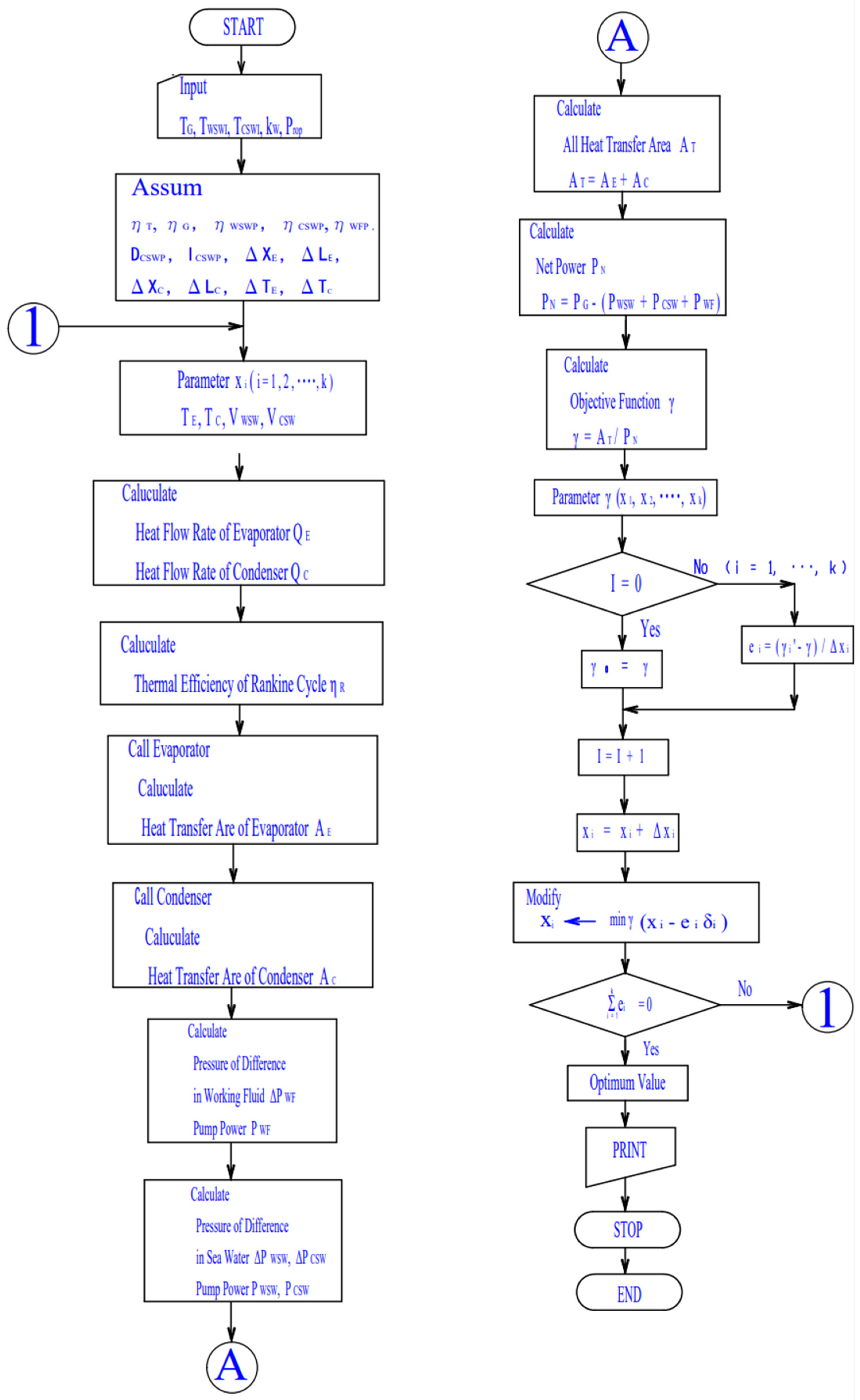

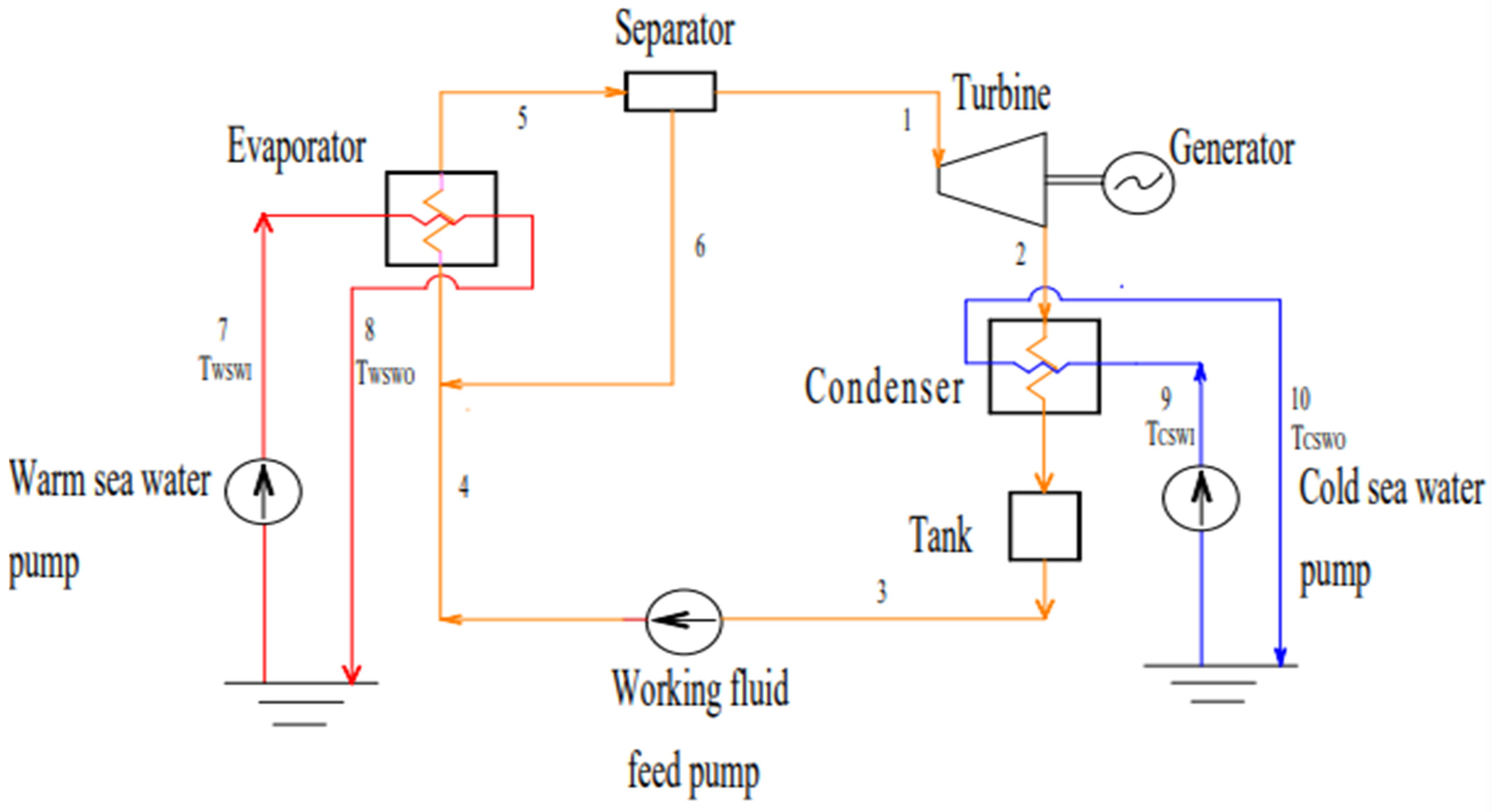
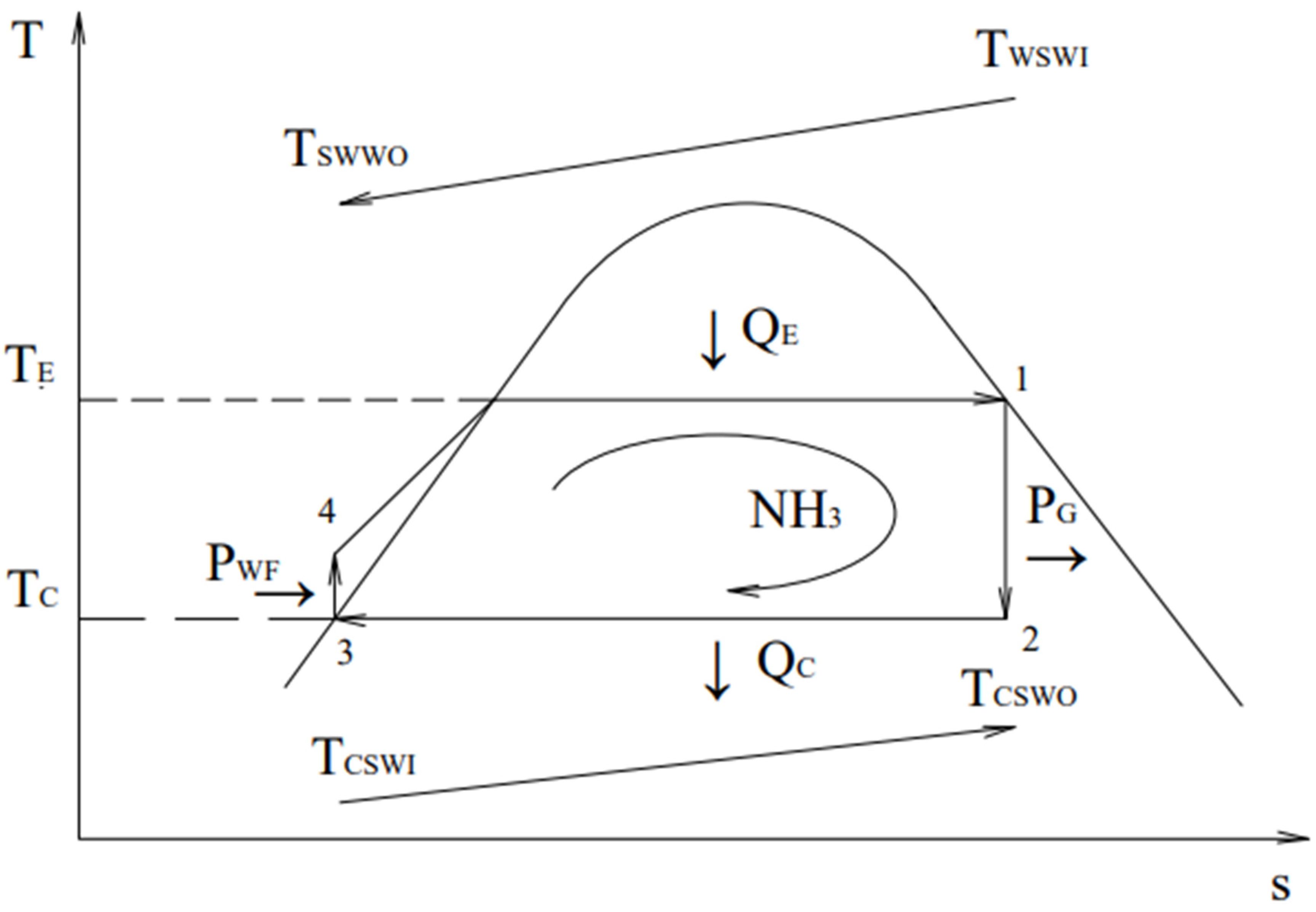
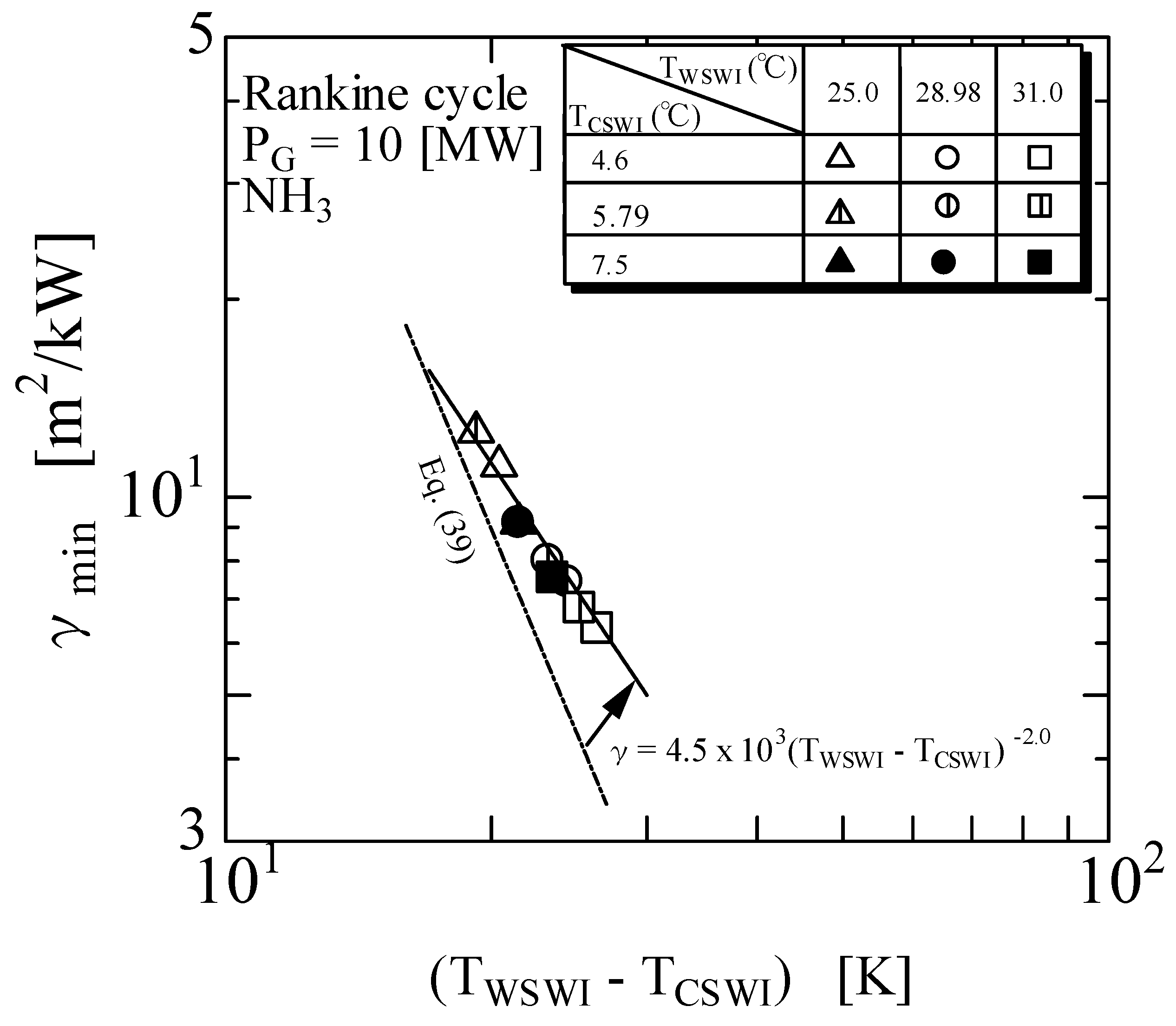
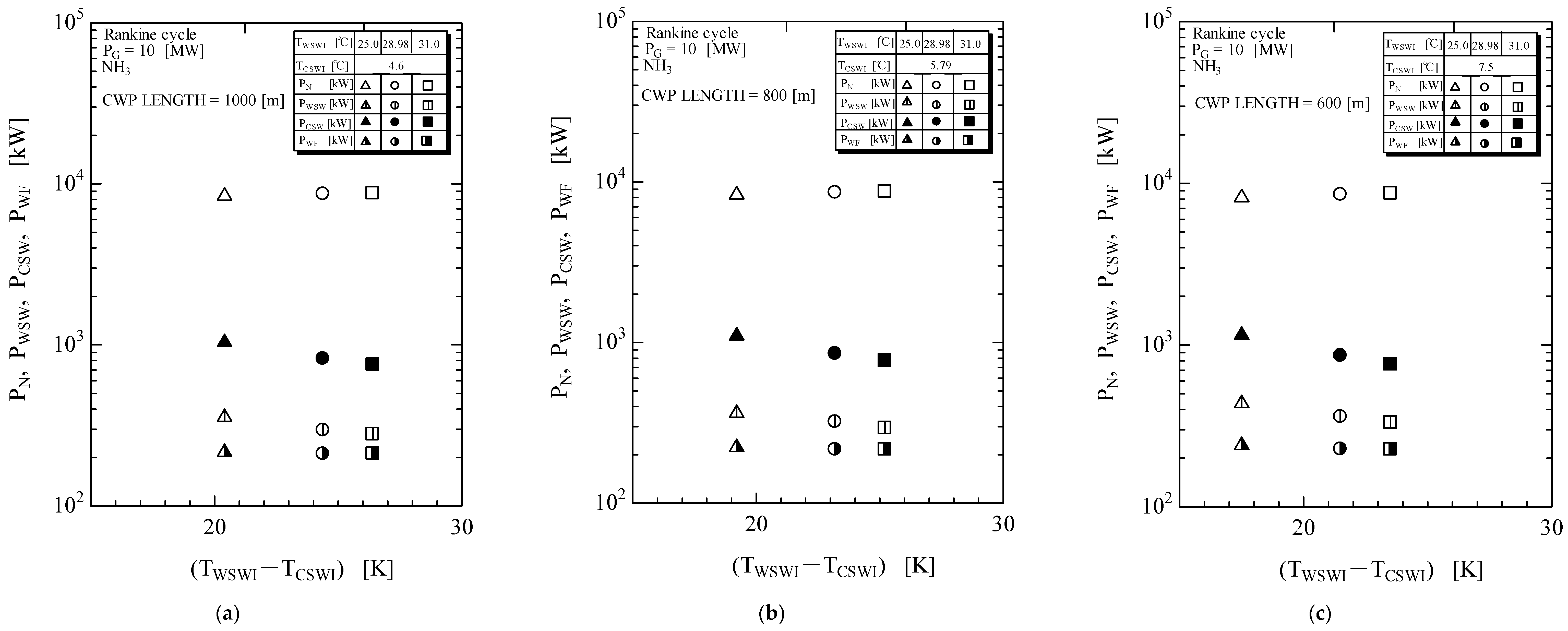


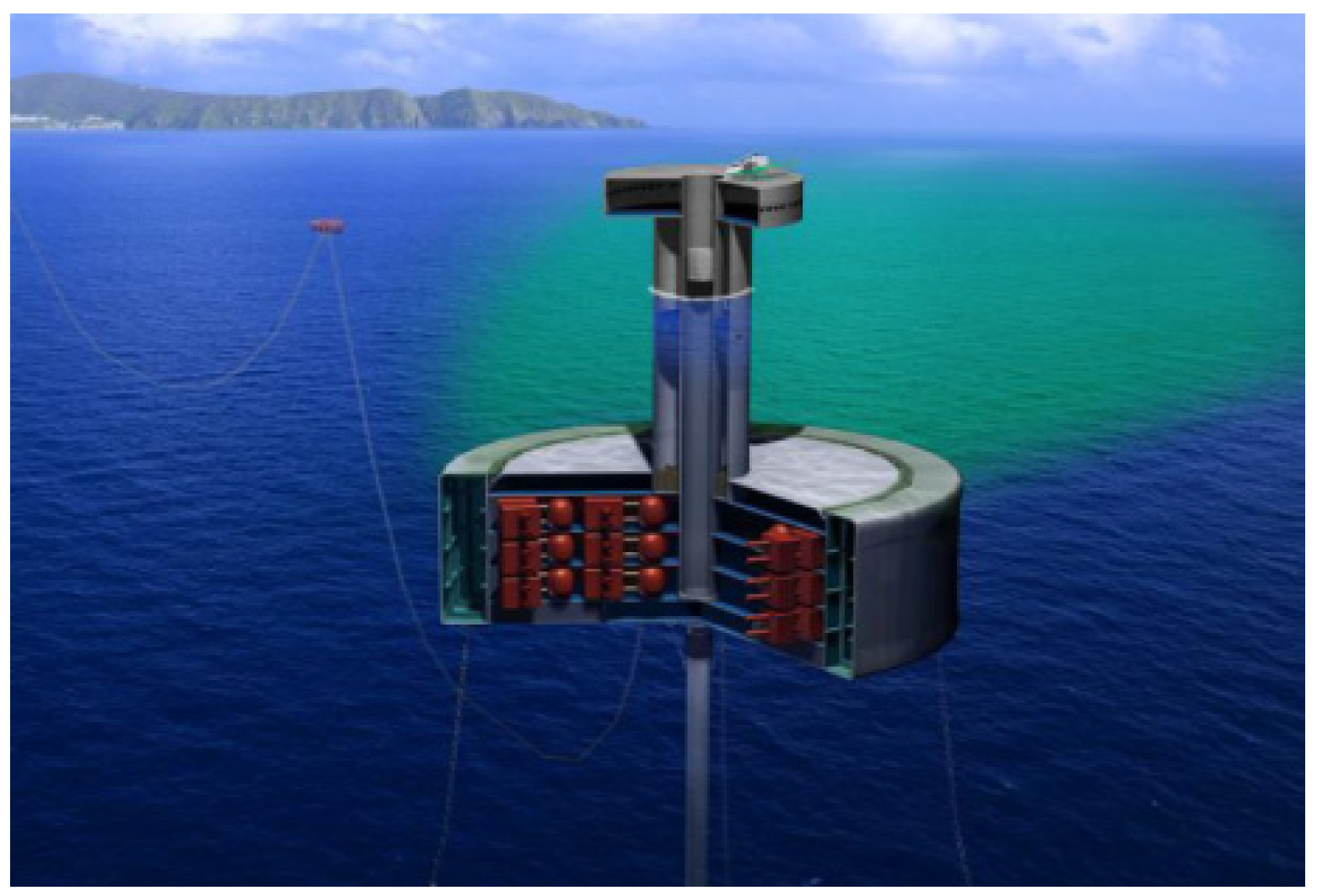
| [MW] | 10 |
| [°C] | 25.0, 28.98, 31.0 |
| [°C] | 4.6, 5.79, 7.5 |
| [m] | 1000, 800, 600 |
| [m] | 5 |
| Dimensions of Evaporator and Condenser | ||
| [m] | 4 |
| [m] | 1.5 |
| [mm] | 1 |
| [mm] | 5 |
| [mm] | 5 |
| [W/m K] | 14.76 |
| [%] | 85 |
| [%] | 80 |
| [%] | 75 |
| [%] | 96 |
Disclaimer/Publisher’s Note: The statements, opinions and data contained in all publications are solely those of the individual author(s) and contributor(s) and not of MDPI and/or the editor(s). MDPI and/or the editor(s) disclaim responsibility for any injury to people or property resulting from any ideas, methods, instructions or products referred to in the content. |
© 2023 by the authors. Licensee MDPI, Basel, Switzerland. This article is an open access article distributed under the terms and conditions of the Creative Commons Attribution (CC BY) license (https://creativecommons.org/licenses/by/4.0/).
Share and Cite
Thirugnana, S.T.; Jaafar, A.B.; Rajoo, S.; Azmi, A.A.; Karthikeyan, H.J.; Yasunaga, T.; Nakaoka, T.; Kamyab, H.; Chelliapan, S.; Ikegami, Y. Performance Analysis of a 10 MW Ocean Thermal Energy Conversion Plant Using Rankine Cycle in Malaysia. Sustainability 2023, 15, 3777. https://doi.org/10.3390/su15043777
Thirugnana ST, Jaafar AB, Rajoo S, Azmi AA, Karthikeyan HJ, Yasunaga T, Nakaoka T, Kamyab H, Chelliapan S, Ikegami Y. Performance Analysis of a 10 MW Ocean Thermal Energy Conversion Plant Using Rankine Cycle in Malaysia. Sustainability. 2023; 15(4):3777. https://doi.org/10.3390/su15043777
Chicago/Turabian StyleThirugnana, Sathiabama T., Abu Bakar Jaafar, Srithar Rajoo, Ahmad Aiman Azmi, Hariharan Jai Karthikeyan, Takeshi Yasunaga, Tsutomu Nakaoka, Hesam Kamyab, Shreeshivadasan Chelliapan, and Yasuyuki Ikegami. 2023. "Performance Analysis of a 10 MW Ocean Thermal Energy Conversion Plant Using Rankine Cycle in Malaysia" Sustainability 15, no. 4: 3777. https://doi.org/10.3390/su15043777
APA StyleThirugnana, S. T., Jaafar, A. B., Rajoo, S., Azmi, A. A., Karthikeyan, H. J., Yasunaga, T., Nakaoka, T., Kamyab, H., Chelliapan, S., & Ikegami, Y. (2023). Performance Analysis of a 10 MW Ocean Thermal Energy Conversion Plant Using Rankine Cycle in Malaysia. Sustainability, 15(4), 3777. https://doi.org/10.3390/su15043777









